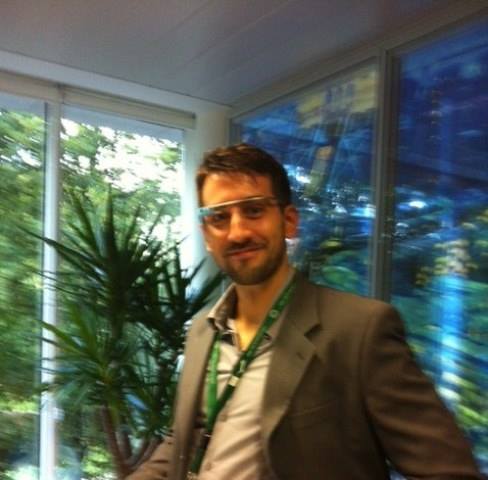Follow @marcoRecorder
Right, here we go. I finally managed to try Google Glass. It was at Google’s offices in Brussels (lovely offices by the way) some time ago. I had a lot of expectations from this product. I had noticed already that a few well-known communications and innovation experts had been already given Google Glass for trial and test but still it was hard for me to understand what this item could actually do. Besides, the hype around them has been really huge especially since the release of the first teaser video in 2012 so, I was very curious.
The presentation was lovely with a group of well-prepared young American (I think all of them were) Google employees who had been touring around Europe and the rest of the world to provide Google Glass demos.
Google Glass is interesting for specific uses, but you’re going to struggle to find a use for them all the time. It didn’t seem like they’re going to replace looking at your smartphone any time soon.
I’m not a particular fan of wearable computing and I admit I’m not a big fan of people using Siri or talking on the phones directly through their headphones…Brrrrrr They look to me like they have watched too many Wall Street-based movies and they actually look ridiculous. Anyway…
The device lent to me was both light and comfortable possibly also because I’m used to wear glasses . You can wear Google Glass without lenses, so you just have the frame, although Google is planning to make them adaptable for actual prescription lenses. The frame is made of titanium, which you can bend to fit your face without breaking.
Now, let’s talk frankly. When you wear them, you don’t look that cool. Although the Swedish designer did a great job making such device sort of conceivable, you still look a like Vegeta from Dragonball Z who is now claiming that he used to wear Google Glass before it was cool. See picture below in case you were born out of the Dragonball Z generation.
You turn Google Glass on by moving your head up, or tapping the side of the frame. This activates a tiny screen showing the time, and the phrase “OK Glass” floating about 10 centimetres in the upper right part. By saying “OK Glass” you get a menu with a range of options such as “Google…(something)”, “take a picture”, record a video”, “get directions to … “, “send a message to … “, “call somebody”, “hang out with … ” Regardless what I read in other reviews, I actually found it pretty accurate when I asked for instance to get “directions to the Atonium” or to “Google my blog” or to “take a picture.”
The presenter explained that in some cases, it might be good to put up an American accent but that sound recognition is constantly being assessed and improved.
A problem with the voice command is that obviously you are not inaudible. Think about other people’s reactions when hearing a man just shouting things out loud. Can you imagine being on the bus and say “OK Glass, give me directions to the nearest sushi shop…” or something like it, or worse, witnessing something unusual on the streets and start shouting “PHOTO, PHOTO, PHOTO!!!!!” or “RECORD A VIDEO, RECORD A VIDEO!!!!” Let’s not forget that “normal people” don’t do so.
There is a way around this of course. You don’t really need to say: “OK Glass, take a picture”. You can just press a button on the top of the sidepiece, or hold it down for video. But then, why wouldn’t you do it with your smartphone? This brings up the notorious privacy issue since there’s no warning to anyone around you that you’re taking photos or videos. Still, there are plenty of similar conceivable devices already available on the market so I don’t see why this very product would create a different case study.
One of the key strengths of this product is that it shows a considerable effort by Google to impose themselves as innovators. In fact, I see how some niche markets could make good use of Glass like in the medical sphere, in technological research or even (why not?) in sports refereeing.
On the other hand, regular people don’t need to walk around needing to Google things. We use our smartphones for that.


Hi Marco,
I was wandering…what if a person comes next to you and shouts PHOTO with an American accent?
Wearing google glass could be hard in Piazza di Spagna
Good question. Google Glass gets around this problem by using bone conduction, which is the conduction of sound to the inner ear through the bones of the skull. Bone conduction transmission can be used with individuals with normal or impaired hearing.
Bone conduction is one reason why a person’s voice sounds different to him/her when it is recorded and played back. Because the skull conducts lower frequencies better than air, people perceive their own voices to be lower and fuller than others do, and a recording of one’s own voice frequently sounds higher than one expects it to sound.
Good post,
Visit my tech webpage.
http://www.itremotesolutions.com
Thanks
Thanks for flagging your website. Quite interesting.
Reblogged this on GrooveSofts.
Thanks for reblogging!
hmm
It’s the first of it’s type, it was always going to be overpriced, like the release of almost any new product. As for the social awkwardness; they’ll be hoping it becomes normalised, (Staring down at a screen in public places would have been socially awkward, and still is to some extent) I have my doubts it’ll catch on though.
http://en.wikipedia.org/wiki/Google_Glass
http://tinyurl.com/o5jedqy